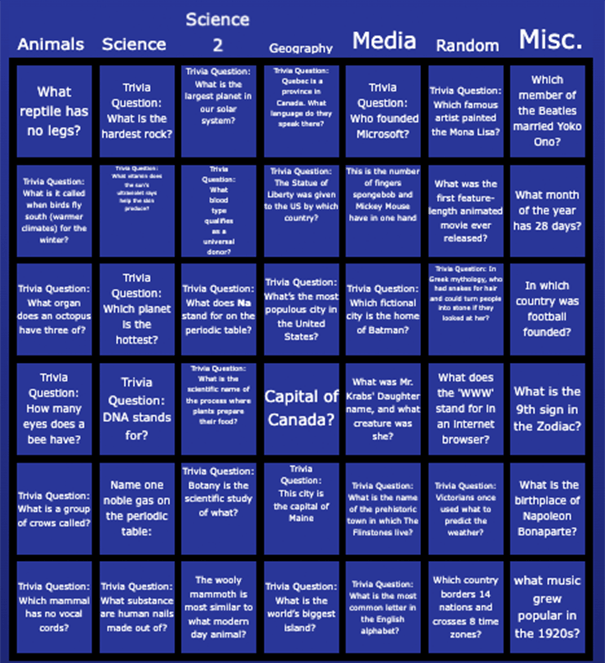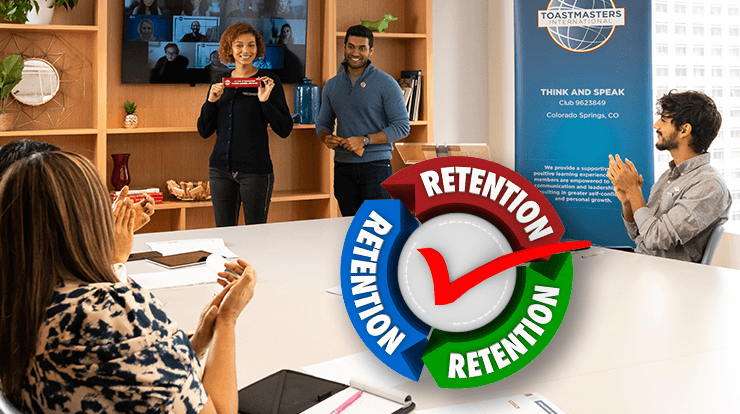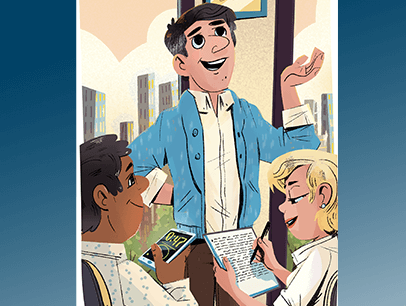Even the most engaged clubs sometimes need a break from their typical meeting agenda. Challenging members with a new activity or leaving the confines of your regular meeting space can bring a renewed sense of energy, as well as fresh challenges.
Trying something different also helps foster a sense of community by asking people to go off course together. Whether it’s a game or some type of adventure, you’re likely to get laughs and a lightened mood. So don’t be afraid to shake it up! A little change may be the energizer your club needs.
Here are some ideas to refresh your meetings.
Reset the agenda.
We Toastmasters love our agendas. Without a minute-by-minute plan, how would the timer know if we were sticking to the prescribed time limits? By this point, most veteran members know the agenda by heart—which is all the more reason to shake things up. Sometimes, making small changes to the order or the meeting format can make a big difference.
Mum’s the word.
In Toastmasters, we learn to think on our feet by actively seeking out ways to incorporate the Word of the Day into our speaking. Why not switch things up by featuring an Anti-Word of the Day? Instead of introducing an uncommon word that people are encouraged to use, identify a common word (or words) that people are not allowed to use. For instance, try giving a Pathways speech without using the word “leadership” or inspiring your audience without using “success.” If someone uses the prohibited word, encourage them to spontaneously reformulate their sentence to avoid it.
In the same way that the Word of the Day expands your vocabulary, an Anti-Word of the Day pushes you to use your existing vocabulary to think of synonyms and new ways to express yourself.
You’re on mute.
Take everyone’s favorite online-meeting phrase to a whole new level by running an entirely silent meeting. While this seems like it contradicts the Toastmasters goal of improving public speaking skills, it actually doesn’t. A silent meeting provides opportunity to home in on non-verbal communication, which makes up anywhere from 60% to 93% of your message (depending on which research study you consult). Use a silent meeting to deep-dive into body language, facial expressions, stage presence, and visual aids.
It might take a bit of imagination, but with a printed agenda, expressive gestures and slides for prepared speeches, charades-like Table Topics®, and written evaluations, you can focus completely on non-verbal communication. The subsequent improvement in these skills will speak for itself.
Fun and Games
In addition to being educational, Toastmasters meetings are inherently enjoyable; that’s why we love them. If you want to boost the fun factor even more, try one of the suggestions below. Game on!
Bingo!
Take advantage of the standard format of a typical Toastmasters meeting. Create bingo cards and label each square with something that will more than likely happen during the session: An evaluation speech goes over its time limit, a humorous speaker makes the audience crack up, or a guest visits the club for the first time. Tailor the cards to your club’s individual quirks—for instance, if one of your members is known to speak often about a particular passion, one square could read, “Carlos talks about golf,” or “Kim mentions her latest travel adventure.”

Toastmasters for 200, please.
Test your club members’ knowledge with a Jeopardy!-themed meeting. The Toastmaster of the Day can be the host; the evaluation team can be the panel of judges. You can play a round or two of trivia during Table Topics, using a tool like JeopardyLabs, or go analog and use flipcharts or construction paper. Participants can choose their clue and answer in the form of a question. This theme lends itself well to educational or training sessions, as well.
A welcome escape.
The last member of your club has just taken their seat and the meeting is about to begin. Just as the President drops the gavel to begin the meeting, the door slams shut—you’re all locked in! In order to escape the meeting room, your club will need to solve riddles, crack codes, and perform tasks (or Table Topics!). Can you make it out before the timer tells you that time is up? Use online resources and your own imagination to create a series of “escape room” activities, and help your club break free of the normal routine.
Mastery and mystery.
Turn your meeting into a Toastmasters mystery event. In contrast to an escape room theme, this meeting idea requires more lead time—because club members have to prepare in advance. In addition to meeting roles, members are given character roles. They come in costume, dressed for their part, and must deliver the assigned information and clues to other participants while remaining in character throughout the course of the meeting. As the session unfolds, attendees work together to listen for, interpret, and combine the clues, using the communication and leadership skills that Toastmasters teaches to piece together the puzzle and identify the culprit.
Location, Location, Location
We all need a change of scenery once in a while. One silver lining of online meetings is the ability to attend from anywhere; you can re-create that feeling of freedom by switching up the location where your in-person meeting is held.
Set the stage.
Try holding a club meeting in a local theater or auditorium. Speaking from an actual stage—complete with lighting, microphones, and an altitude differential between you and the audience—feels completely different than speaking from the front of a classroom or conference room. It’s an excellent chance to practice the technology and technique needed for larger public speaking engagements, and provides your members with their moment in the spotlight.
Take it outside.
Weather willing, plan a meeting outdoors. Whether it’s a local park or a member’s backyard, improve your leadership and communication skills while soaking up some sun. Take the Pathways metaphor to a whole new level by organizing a hike or a nature walk, and/or fortify your members for all the personal development they’re doing with a picnic or a cookout.
Room remodel.
If it’s not realistic to change your location, you can always change your layout. If you typically sit at tables, move them out of the way and set up chairs theater-style instead; if you typically sit in rows, move your chairs into a circle. Relocate the lectern to the opposite side of the space so that the audience is facing a different direction than they normally do—or ask the speakers to move around the room as they talk. It’s amazing how changing your physical viewpoint can change your entire outlook.
New Faces
Sometimes, just having a sea of unfamiliar faces looking back at you can be enough to switch things up and move you out of your comfort zone. In addition to the guests and new members that you regularly bring in to your meetings, actively seek out fresh audiences.
A winning combination.
Hold a combined meeting with another club in your area. You’ll both enjoy a larger audience, and hear speeches and Table Topics responses from Toastmasters with fresh perspectives. (And there’s an added bonus for the guest club: You get the benefit of a new location when you visit the host club’s home base.) You also don’t have to limit yourself to other Toastmasters clubs. Organize a joint meeting with the local Rotary club to get the benefit of fresh faces—and maybe even fresh Toastmasters members.

All in the family.
Hold a family evening, where members are encouraged to bring their significant others, children, parents, or relatives. You could plan a special Team Table Topics theme in which families respond as a group—or ask them questions about each other. Not only will this give the visitors a chance to see their Toastmaster in action, but having their loved ones in the audience might bring out a side of your club members that you haven’t seen before.
Share Your Success
Regardless of the temperature, make a summertime splash and take a vacation from the traditional format. From reimagining your agenda to relocating your meeting, from expanding your audience to playing a game, there are plenty of ways to liven things up.

Club leaders can play a role in such revitalizing. “As Toastmasters officers, we need to develop, continually, a creative atmosphere for members to talk about the exciting meeting experience at their club,” says Julia Calderon, DTM, a member of two clubs in Illinois.
The ideas listed in this article are just the tip of the ice cream cone—there are plenty more possibilities for keeping your meetings fun and fresh. Many clubs and Districts have put together resources and guides, like a Club Programming Idea Cookbook from District 106.
Try out some of these suggestions in your own club, and document your results. What worked? What didn’t? What would you recommend other clubs try? Put together your own set of resources and share your summertime successes with other Toastmasters!
Editor’s Note: Let us know if your club tries any of these suggestions, or other ones. Send your experience or a photo to letters@toastmasters.org.
Megan Preston Meyer is the author of Max Entropy & the Avalanche, as well as Firebrand: A Corporate Elements Mystery and the Supply Jane and Fifo Adventures. She lives in Switzerland and is a regular contributor to the Toastmaster magazine. Learn more at entropycottage.com/max.
Related Articles

Club Experience
Keep 'Em Coming Back

Meeting Roles
Maximize Your Meeting Role Lineup

Online Meetings





 You’ve Got It All Backward
You’ve Got It All Backward

